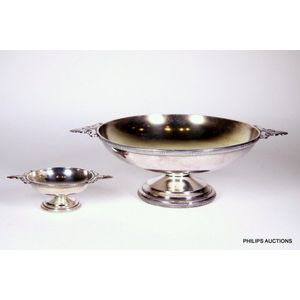19th/20th Century Silver Comport with Classical Female Profiles
You must be a subscriber, and be logged in to view price and dealer details.
Subscribe Now to view actual auction price for this item
When you subscribe, you have the option of setting the currency in which to display prices to $Au, $US, $NZ or Stg.
- Acanthus - A stylized leaf motif, one of the primary decorative elements of classical Greek and Roman architecture, derived from the genus of flowering plants in the family Acanthaceae, native to tropical and subtropical regions of the Mediterranean area. It is a common element in classical Greek and Roman design, and is often seen in Corinthian and Composite order columns and used as a decorative element in English, European and Australian furniture, particularly on the curve of a leg, and as decoration for a corbel.
- Comport - A comport is a type of decorative serving dish or bowl, typically used for desserts, fruits or other sweet treats. The comport is usually made from glass, silver or porcelain, which are materials known for their elegance and durability. They are often beautifully designed and decorated, and can be used as an elegant and decorative centerpiece for a table or dining room. They are also widely used as a decorative piece on the mantelpiece, sideboard, or other areas of the house.
- Pineapple - The pineapple, named because of its resemblance to a pine cone, was an exotic and scarce fruit in the 18th century. It became a popular decorative motif on furniture, silver ceramics, glass and clocks during this time.
This item has been included into following indexes:
- bowls and dishes, silver
- comports - silver items 145
Visually similar items

A George V sterling silver bon bon dish, 1911 London, with maker's mark for Thomas Bradbury & Sons, the oval footed dish with a linen fold rim and scalloped edging; hallmarked to body underside. Silver weight 119gr. Height 5.5 cm. Width 13 cm. Depth 10.5 c

A Continental silver plated comport and eleven small dishes, early to mid 20th century, a dessert service comprising a circular gilded dish with gadrooned edges to the bowl and foot, and twin cast handles with palmettes and scrolls, the small bowls conform

A solitaire diamond ring, the central round brilliant cut diamond of known weight 1.24 carats, the split shoulders grain set with round brilliant cut diamonds totalling 0.20 carats. Platinum. Weight 7.49 grams. Size L. Accompanied by GIA Certificate number

Large Continental silver bowl beautifully chased with Byzantine, Venetian, Jerusalem, and Plantagenet crest. Marked S 800, approx, 600g 10 cm high, 22 cm diameter
